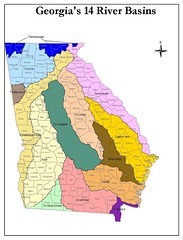 Apparently whoever is responsible for a major spill into Georgia waters
needs to immediately tell GA EPD DNR and the local health department
and post a sign, and
the sewage leak at GA 133 into the Withlacoochee River
qualifies as a major spill.
The City of Valdosta reported it as such, but it’s not clear it was their spill (update: it was Lowndes County’s spill).
Excerpts below from GA DNR’s guidelines.
-jsq
Apparently whoever is responsible for a major spill into Georgia waters
needs to immediately tell GA EPD DNR and the local health department
and post a sign, and
the sewage leak at GA 133 into the Withlacoochee River
qualifies as a major spill.
The City of Valdosta reported it as such, but it’s not clear it was their spill (update: it was Lowndes County’s spill).
Excerpts below from GA DNR’s guidelines.
-jsq
Water Quality: A Guide for Municipal Compliance by Mick Smith, Environmental Engineer.
Spills and Major Spills
Spill
- Any discharge of raw sewage < 10,000 gallons to waters of the state
Major Spill
- Any discharge of raw sewage > 10,000 gallons to waters of the state
- BOD5 or TSS = 1.5 x weekly avg. permit limit
- Any discharge resulting in a water quality violation
Waters of the State
- “any and all rivers,streams, creeks, branches, lakes, reservoirs, ponds, drainage systems, springs, wells, wetlands and all bodies of surface or subsurface water, natural or artificial, lying within or forming a part of the boundaries of the State which are not entirely confined and retained completely upon the property of a single individual, partnership or corporation”
Response to Spill
- Immediately contact EPD by phone or in person.
- Immediately report the spill to the local health Department.
- Immediately post notice at spill site where spill occurred.
- Within 24 hours of becoming aware of spill, report to local media date of spill, location, cause, volume discharged, receiving waters, and corrective actions taken to mitigate impact.
- Within 5 days of spill submit written report to EPD concerning date of spill, location and cause, estimated volume and name of receiving waters, and corrective actions taken to mitigate impacts.
Response to Major Spill
- Immediately contact EPD by phone or in person.
- Immediately report the spill to the local health Department.
- Immediately post notice at spill site where spill occurred.
- Immediately establish year long monitoring program, upstream and downstream of major spill site to include:
- Dissolved Oxygen
- Fecal Coliform Bacteria
- pH
- Temperature
- Additional parameters required by EPD
- Typical frequency: every – day/week, week/month, month/year
- Within 24 hours of becoming aware of spill, report to local media date of spill, location, cause, volume discharged, receiving waters, and corrective actions taken to mitigate impact.
- Within 24 hours of becoming aware of the major spill provide notice to downstream public water supply withdrawal agencies within a 20 mile distance.
- Within 5 days of spill submit written report to EPD concerning date of spill, location and cause, estimated volume and name of receiving waters, and corrective actions taken to mitigate impacts.
- Within 7 days of the major spill publish notice in legal organ of county where the major spill occurred informing of date, location, cause, estimated volume and name of receiving waters, and corrective actions taken.
Short Link: